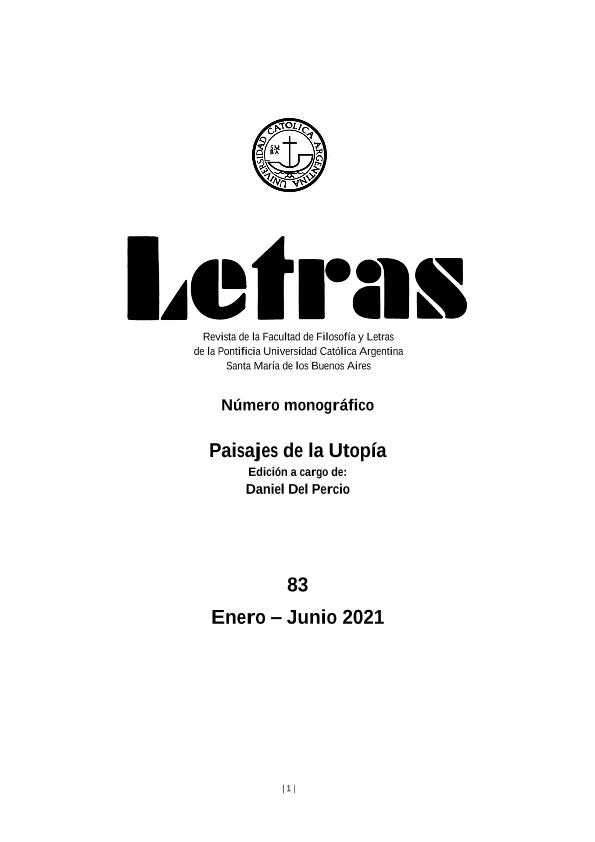Mostrar el registro sencillo del ítem
dc.contributor.author
Martinez, Carolina

dc.date.available
2022-10-14T13:21:14Z
dc.date.issued
2021-11
dc.identifier.citation
Martinez, Carolina; Cartografías de utopía, o cómo leer un mapa de un no-lugar en la modernidad temprana; Pontificia Universidad Católica Argentina Santa María de los Buenos Aires; Letras; 83; 11-2021; 21-37
dc.identifier.issn
0326-3363
dc.identifier.uri
http://hdl.handle.net/11336/173192
dc.description.abstract
El artículo indaga sobre la presencia de imágenes cartográficas en relatos de viaje imaginarios producidos en la modernidad temprana europea. Para ello analiza los mapas que acompañaron las ediciones de 1516 y 1518 de Utopía, la versión realizada por Abraham Ortelius hacia 1595 y aquel incluido en la Histoire du Grand et Admirable Royaume d'Antangil, publicada en la ciudad francesa de Saumur en 1616. El texto reconfirma que, más allá del carácter imaginario o mimético de cualquier mapa, es el contexto enunciativo el que habilita su correcta lectura. A la vez, sostiene que tanto los mapas ficticios temprano-modernos cuanto el género utópico fueron ejercicios de extrañamiento representativos del período en cuestión.
dc.description.abstract
This article examines the presence of cartographic images in a set of imaginary travel accounts produced in early modern Europe. In order to do so, it analyzes the maps included the 1516 and 1518 editions of Utopia, the map of Utopia done by Abraham Ortelius in 1595 and the map included in the Histoire du Grand et Admirable Royaume d'Antangil, published in the French city of Saumur in 1616. The article reconfirms that, whether imaginary or mimetic in character, it is the map’s enunciative context that enables its “correct” reading. At the same time, the article argues that both the early-modern fictional map and the utopian genre were the product of operations of estrangement representative of that historical period.
dc.format
application/pdf
dc.language.iso
spa
dc.publisher
Pontificia Universidad Católica Argentina Santa María de los Buenos Aires
dc.rights
info:eu-repo/semantics/openAccess
dc.rights.uri
https://creativecommons.org/licenses/by-nc-sa/2.5/ar/
dc.subject
UTOPIA
dc.subject
MAPA
dc.subject
ANTANGIL
dc.subject
CARTOGRAFIA
dc.subject.classification
Historia

dc.subject.classification
Historia y Arqueología

dc.subject.classification
HUMANIDADES

dc.title
Cartografías de utopía, o cómo leer un mapa de un no-lugar en la modernidad temprana
dc.title
Cartographies of Utopia, or How to Read a Map of Nowhere in the Early Modern Period
dc.type
info:eu-repo/semantics/article
dc.type
info:ar-repo/semantics/artículo
dc.type
info:eu-repo/semantics/publishedVersion
dc.date.updated
2022-09-21T10:36:10Z
dc.identifier.eissn
2683-7897
dc.journal.number
83
dc.journal.pagination
21-37
dc.journal.pais
Argentina

dc.journal.ciudad
Ciudad Autónoma de Buenos Aires
dc.description.fil
Fil: Martinez, Carolina. Universidad Nacional de San Martin. Escuela de Humanidades. Laboratorio de Investigacion En Ciencias Humanas. - Consejo Nacional de Investigaciones Cientificas y Tecnicas. Oficina de Coordinacion Administrativa Pque. Centenario. Laboratorio de Investigacion En Ciencias Humanas.; Argentina
dc.journal.title
Letras
dc.relation.alternativeid
info:eu-repo/semantics/altIdentifier/url/https://erevistas.uca.edu.ar/index.php/LET/article/view/3717
dc.relation.alternativeid
info:eu-repo/semantics/altIdentifier/doi/https://doi.org/10.46553/LET.83.2021.p21-37
Archivos asociados
